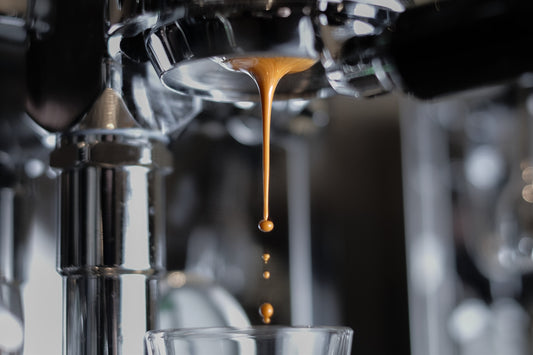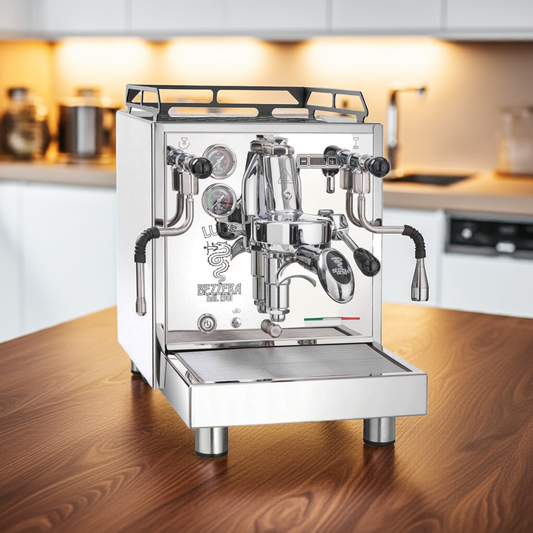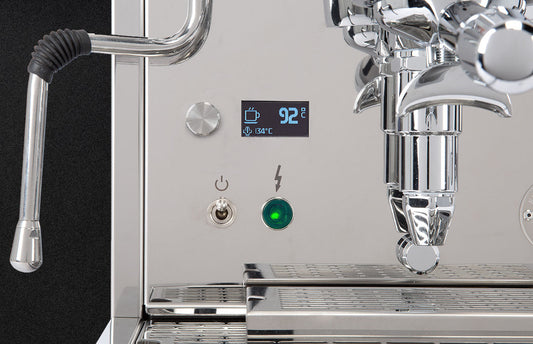When looking for the right portafilter machine, one of the most important questions is: single-circuit, dual-circuit, or dual-boiler? But how exactly do these three design variants differ from each other? In the first part of this three-part series, we'll look at the most common system, the dual-circuit.
As already mentioned in the article on the E61 brewing group, the system with two circuits and one boiler was developed by Italian designer Ernesto Valente, along with the legendary E61. However, it took several years before this system was also used in small household machines. Initially, the catering systems were simply installed with smaller boilers, which, however, led to significant overheating of the system after longer periods of inactivity between brews. To understand the cause of this problem, we need to take a closer look at how it works. Let's start with the structure of the boiler.

BOILER
Not all boilers are created equal. They come in all shapes and sizes: upright, horizontal, 700ml, 1700ml, copper, stainless steel [...] The graphic is based on a model used in Bezzera models. Essentially, the boiler consists of three components: the actual boiler, the heating element (left), and the heat exchanger (right). As already mentioned, the volume of the boiler can vary greatly; for most machines, it is between 1.5 and 2 liters. The boiler volume is a key factor for temperature stability; the greater the amount of hot water in the boiler, the less effective the incoming cold water is. This is offset by the higher energy requirement to heat the water to or maintain it at the right temperature. Of course, it must be noted that a larger boiler can also have a lower fill level; this increases steam output, as more volume is available for steam. It is already clear that a multitude of variables must be considered during design, and that a boiler is more than just a simple copper cylinder.
HEAT EXCHANGER
The heat exchanger is essentially a small boiler inside the boiler itself. However, it is not directly heated, but rather passively heated by the water from the main boiler. The water from the two areas never touches each other. Two lines are connected to the heat exchanger, both of which lead directly to the brewing group. These two lines are part of a system whose name alone can be confusing: "The thermosyphon." We'll explain exactly how this works in the next section.
THERMOSYPHON
The thermosyphon is the component that enables the dual-circuit machine to operate at two different temperatures. The fundamental problem lies in the fact that the main boiler must be operated at a temperature of approximately 125°C to achieve a steam output of approximately 1 bar. This is clearly far too high for the brewing process. This is where the heat exchanger, with its two connected lines, comes into play. These lines lead to a chamber in the upper area of the brewing group. When the machine is switched on, the heat exchanger, the two lines, and the chamber in the brewing group are filled with cold water. As the water in the main boiler heats up, the temperature in the heat exchanger also rises. The warm water wants to expand, and the only way is through the connected lines into the brewing group. The cold water is "pushed" into the heat exchanger, where it is heated, and then makes its way back to the brewing group. Two tricks ensure that the circulation doesn't stop once the entire system has reached temperature. Trick 1: The supply line is flanged to the top of the brewing group, and the return line is flanged to the bottom. As the water cools, it sinks within the brewing group. Trick 2: The return line is longer than the supply line, so the water in it cools more rapidly. Due to the circulation, the temperature in the circuit is lower than that in the main boiler.
THE OVERALL SYSTEM
If we now put all three components together, the following picture emerges: The main boiler runs at around 120-125°C and is about 2/3 full. This leaves enough volume for steam so that the pressure remains constant during frothing. The heat exchanger is located in the main boiler and absorbs the ambient temperature. This creates a circuit through the brewing group in which the water cools down. The length and cross-section of the inlet and outlet lines can be used to influence the circulation speed and thus the temperature in the coffee circuit. In the area of household appliances, a setting has become established whereby at a brewing temperature of around 92°C, the steam pressure is around 1-1.2 BAR. One factor that we have completely neglected so far is the situation as soon as cold water is pumped into the system during brewing. A compromise must be found between a stable idle temperature and consistency when brewing many times in a short period of time. The result is that most dual-circuit machines overheat slightly after being idle for an extended period. The solution is the cooling flush. Before brewing, water is allowed to flow from the brewing group for a few seconds. After that, the temperature returns to its optimal level. The first household dual-circuit machines used the same pipes as commercial machines, but these were designed for continuous operation. As a result, the machines overheated quickly. This reputation still clings to dual-circuit machines today, but thanks to the aforementioned adjustments, the temperature fluctuations in today's machines are minimal.




